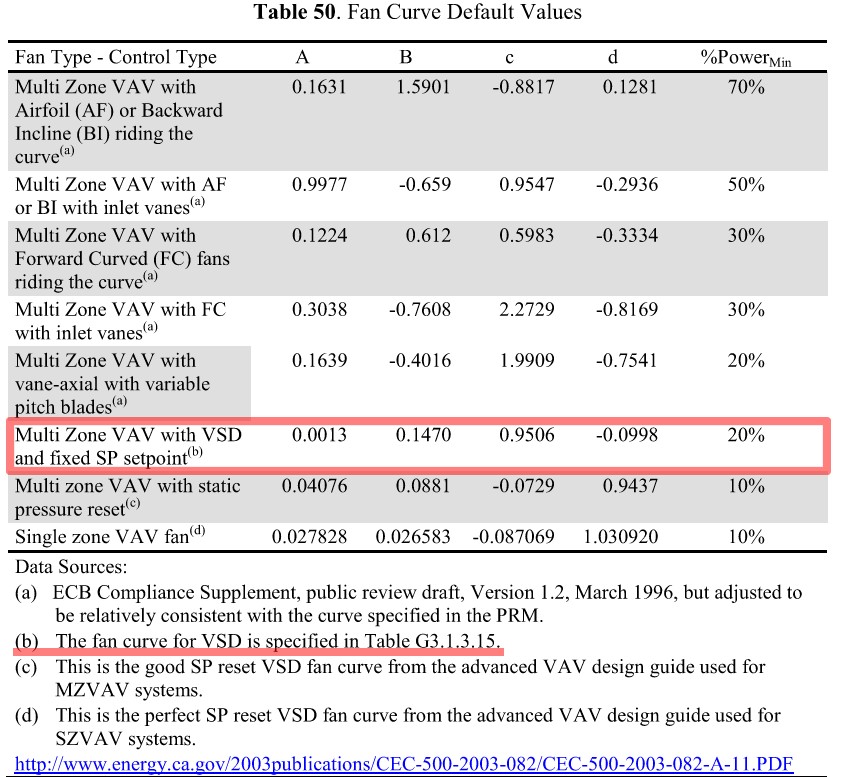ASHRAE/IECC Baseline VAV Fan Curves and Min Flow Fraction
What are the appropriate fan curve coefficients and Fan Power Minimum Flow Fraction for the Fan:VariableVolume objects in an ASHRAE 90.1 PRM baseline model (System 5)?
I ask because there are some discrepancies between the ASHRAE/IECC code language and the Commercial Prototype Building Models. As noted in a previous Unmet Hours post, the prototype models use coefficients representing "Good SP Reset VSD Fan", which differ from the coefficients from 90.1 App G Method 2. Is this because the prototypes assume zone-level DDC where a SP reset would be required?
Regarding the "Fan Power Minimum Flow Fraction" field, both ASHRAE 90.1-2013 (6.5.3.2.1) and IECC 2015 (C403.4.1.1) state: "Low or minimum speed shall not exceed 66% of full speed. At low or minimum speed, the fan system shall draw no more than 40% of the fan power at full fan speed." I interpret this as meaning the baseline "Fan Power Minimum Flow Fraction" should be 0.66. However, the prototype models use a fraction of 0.25. What is the appropriate Fan Power Minimum Flow Fraction for a PRM baseline?
Another unrelated discrepancy I found in the prototype models for System 5 (used in medium office). ASHRAE (G3.1.1-4 Baseline System Descriptions) lists hot water boiler heating, whereas the prototypes use gas furnace heating. Are the ASHRAE prototype models not intended to represent ASHRAE ECB baseline models?










Any answers?
Fan Power Minimum Flow Fractionof 0.25 is the default value in EnergyPlus, but it's unrealistic to me, especially for 3-phase plug fans in AHU. Minimum frequency for fans with VSD varies slightly by manufacturers, but I often see that it is 30Hz i.e. the minimum flow fraction = 30Hz / 60Hz(Rated frequency) = 0.5.Besides, in my understanding, Commercial Prototype Building Models are not the ASHRAE Baseline models.
I'm not very knowledgeable about the decisions that were made when creating the Commercial Prototype Building Models, but they are not meant to be ASHRAE Baseline models. They are supposed to be representative of the national building stock. The prototype models are derived from DOE's Commercial Reference Building Models.
If the prototype models don't represent Baseline models (ECB Method), why are they developed for each code/standard year? They must at least be in compliance with the standard year which they represent. But perhaps they don't necessarily represent minimum compliance?
If you look through the Scorecard spreadsheet files for the prototype models, you'll notice that there is a lot of overlap with Baseline models, but that there are also some differences. It seems like envelope, HVAC, etc types are based on CBECS 2003 and other sources, but then the performance data is based on applicable codes or standards (i.e. Standard 90.1). Therefore, they are really similar to the Baseline models but not exactly the same if that makes sense.
If you want to know the min flow fraction of ASHRAE Baseline System 5, I think 6.5.3.2.1 b is a better clue rather than 6.5.3.2.1 a because System 5 is VAV.
6.5.3.2.1 b. All other units, including DX cooling units and chilled-water units that control the space temperature by modulating the airflow to the space, shall have modulating fancontrol. Minimum speed shall not exceed 50% of fullspeed. At minimum speed, the fan system shall draw nomore than 30% of the power at full fan speed. Low or minimum speed shall be used during periods of low cooling load and ventilation-only operation.